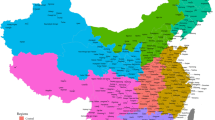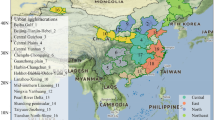Abstract
Urban air pollution is a commonly concerned environmental problem in the world. Identification of air quality trend using long-term monitoring data is helpful to understand the effectiveness of pollution control strategies. This study, using data from six monitoring stations in Zhengzhou City, analyzed the changing trend in concentrations of SO2, NO x /NO2 and TSP/PM10 in 1996–2008, based on non-parametric Mann-Kendall test and Sen’s slope estimator, and evaluated the comprehensive air pollution level using Multi-Pollutant Index (MPI). It was found that the concentration of each pollutant exceeded obviously the World Health Organization (WHO) guideline value, but the changing trend varied: SO2 and NO2 were significantly increased mainly due to an increase in coal consumption and vehicle number, while NO x , TSP and PM10 decreased. The air pollution was serious, and differed markedly among the three functional regions: it is the most severe in the Industrial and Residential Area (IRA), followed by the Transportation Hub and Business District (THBD), and then the High-tech, Cultural and Educational Area (HCEA). Different from NO2 concentration that had a similar change trend/rate among the function regions, the change rate of PM10 concentration differed spatially, decreased much more obviously in THBD than other two regions. For the whole city, the comprehensive air pollution level declined gradually, illustrating that the air quality in Zhengzhou was improved in the last decade.
Similar content being viewed by others
References
Anttila P, Tuovinen J P, 2010. Trends of primary and secondary pollutant concentrations in Finland in 1994-2007. Atmospheric Environment, 44(1): 30–41. doi: 10.1016/j.atmosenv.2009.09.041
Baldasano J M, Valera E, Jiménez P, 2003. Air quality data from large cities. The Science of the Total Environment, 307(1–3): 141–165. doi: 10.1016/S0048-9697(02)00537-5
Branis M, 2009. Air quality of Prague: traffic as a main pollution source. Environmental Monitoring and Assessment, 156(1–4): 377–390. doi: 10.1007/s10661-008-0491-3
Buringh E, Fischer P, Hoek G, 2000. Is SO2 a causative factor for the PM-associated mortality risks in the Netherlands? Inhalation Toxicology, 12(Supplement 1): 55–60. doi: 10.1080/089583700196383
Chan C K, Yao X H, 2008. Air pollution in megacities in China. Atmospheric Environment, 42(1): 1–42. doi: 10.1016/j.atmosenv.2007.09.003
Ebelt S, Brauer M, Cyrys J et al., 2001. Air quality in postunification Erfurt, East Germany: Associating changes in pollutant concentration with changes in emissions. Environmental Health Perspectives, 109(4); 325–333. doi: 10.1289/ehp.01109325
Fenger J, 1999. Urban air quality. Atmospheric Environment, 33(29): 4877–4900. doi: 10.1016/S1352-2310(99)00290-3
Fenger J, 2009. Air pollution in the last 50 years—From local to global. Atmospheric Environment, 43(1): 13–22. doi: 10.1016/j.atmosenv.2008.09.061
FMI (Finnish Meteorological Institute), 2002. Mann-Kendall Test and Sen’s Slope Estimates for the Trend of Annual Data. Available at: http://www.ilmanlaatu.fi/ilmansaasteet/julkaisu/julkaisu.php
Glibert R O, 1987. Statistical Methods for Environmental Monitoring. New York: Pacific Northwest Laboratory, 205–224.
Gurjar B R, Butler T M, Lawrence M G, et al., 2008. Evaluation of emissions and air quality in megacities. Atmospheric Environment, 42(7): 1593–1606. doi: 10.1016/j.atmosenv.2007.10.048
He Pingfen, Yue Xiaoxin, Liu Pingbo et al., 2006. Air pollutant associated with respiratory tract infection in Zhengzhou City. Chinese Journal of Clinical Rehabilitation, 10(36): 1–3. (in Chinese)
HPBS (Henan Provincial Bureau of Statistics), 1991–1999. Henan Statistical Yearbook. Beijing: China Statistics Press. (in Chinese)
Hou Yaming, 2004. Zhengzhou ambient air pollution character analyze. Henan Science, 22(2): 273–276. (in Chinese)
Kyle A D, Woodruff T J, Buffler P A et al., 2002. Use of an index to reflect the aggregate burden of long-term exposure to criteria air pollutants in the United States. Environmental Health Perspectives, 110(Supplement 1): 95–102. doi: 10.1289/ehp.02110s195
Laschober C, Limbeck A, Rendl J et al., 2004. Particulate emissions from on-road vehicles in the Kaisermuhlen-tunnel (Vienna, Austria). Atmospheric Environment, 38(14): 2187–2195. doi: 10.1016/j.atmosenv.2004.01.017
Lee J T, Kim H, Hong Y C, 2000. Air pollution and daily mortality in seven major cities of Korea, 1991–1997. Environmental Research Section A, 84(3): 247–254. doi: 10.1006/enrs.2000.4096
Li Lin, Hao Jiming, Hu Jingnan, 2005. Analysis and prediction of air quality influence from energy utilization in Beijing. China Environmental Science, 25(6): 746–750. (in Chinese)
Liu Ying, Zhao Rongqin, Xu Mingpo, 2008. Analysis of Spatial Structure Changes of Zhengzhou. Modern Urban Research, 23(3): 61–66. (in Chinese)
Lu Xiaofeng, 2008. Dynamic monitoring of urban expansion based on RS and GIS technology-a case study of Zhengzhou City. Journal of Henan Polytechnic University (Natural Science), 27(2): 182–187. (in Chinese)
Mayer H, 1999. Air pollution in cities. Atmospheric Environment, 33(24–25): 4029–4037. doi: 10.1016/S1352-2310(99)00144-2
MEP (Ministry of Environmental Protection of the People’s Republic of China), 2005. China has one fifth of the urban population living in air polluted environments. Available at: http://websearch.mep.gov.cn/was40/detail?record=1&primarykeyvalue=RECID%3D138986&channelid=54582&searchword=%E4%B8%AD%E5%9B%BD%E5%9F%8E%E5%B8%82%E7%A9%BA%E6%B0%94%E6%B1%A1%E6%9F%93&sortfield=-docreltime. (in Chinese)
MEPB (Municipal Environmental Protection Bureau of Zhengzhou City), 2004. Records of Environmental Protection Activities in Zhengzhoiu City. Zhengzhou: Zhongzhou Ancient Books Publishing House, 100–300. (in Chinese)
Ning Datong, Whitney J B, Yap D, 1987. Urban air pollution and atmospheric diffusion research in China. Environmental Management, 11(6): 721–728. doi: 10.1007/BF01867239
Partal T, Kahya E, 2006. Trend analysis in Turkish precipitation data. Hydrological Processes, 20(9): 2011–2026. doi: 10.1002/hyp.5993
Ramanathan V, Feng Y, 2009. Air pollution, greenhouse gases and climate change: Global and regional perspectives. Atmospheric Environment, 43(1): 37–50. doi: 10.1016/j.atmosenv.2008.09.063
RGCMS (Research Group for China Modernization Strategies), CCMR (China Center for Modernization Research, Chinese Academy of Sciences), 2007. China Modernization Report Outlook (2001–2007)—Ecological Modernization Study. Beijing: Peking University Press, 208–224. (in Chinese)
Serrano A, Mateos V L, Garcia J A, 1999. Trend analysis of monthly precipitation over the Iberian Peninsula for the period 1921–1995. Physics and Chemistry of the Earth (B), 24(1–2): 85–90. doi: 10.1016/S1464-1909(98)00016-1
Sen P K, 1968. Estimates of the regression coefficient based on Kendall’s tau. Journal of the American Statistical Association, 63(324): 1379–1389. doi: 10.2307/2285891
Sicard P, Coddeville P, Sauvage S et al., 2007. Trends in chemical composition of wet-only precipitation at rural French monitoring stations over the 1990–2003 period. Air, Water, and Soils Pollution, 7(1–3): 49–58. doi: 10.1007/s11267-006-9093-7
Sicard P, Mangin A, Hebel P et al., 2010. Detection and estimation trends linked to air quality and mortality on French Riviera over the 1990–2005 period. Science of the Total Environment, 408(8): 1943–1950. doi: 10.1016/j.scitotenv.2010.01.024
Singh A K, Gupta H K, Gupta K et al., 2007. A comparative study of air pollution in Indian cities. Bulletin of Environmental Contamination and Toxicology, 78(5): 411–416. doi: 10.1007/s00128-007-9220-9
Sun Zhongdang, Zhao Yong, Tian Chao et al., 2003. Study on grey prediction NOx concentration in atmosphere and its pollution. Chongqing Environmental Sciences, 25(1): 52–55. (in Chinese)
Tian Chao, Fan Xiangge, Zhang Wenli et al., 2001. Establishment of the diffus-ing model of atmospheric infectant SO2 and its application. Journal of Henan Agricultural University, 35(3): 234–237. (in Chinese)
Tang Huijun, 2004. Study on distribution regularity of the air pollution in Guangzhou City. Geographical Research, 23(4): 495–503. (in Chinese)
Vardoulakis S, Kassomenos P, 2008. Sources and factors affecting PM10 levels in two European cities: Implications for local air quality management. Atmospheric Environment, 42(17): 3949–3963. doi: 10.1016/j.atmosenv.2006.12.021
Wang Weiwu, Chen Chao, 2008. A quantitative analysis on spatial distribution of the pollutants in the urban air and their impact factors based on geostatistics and GIS: A case study of Hangzhou city. Geographical Research, 27(2): 241–249. (in Chinese)
Wei Yi, Jia Xuhui, Wei Yong, 2011. Total quantity control and reduction system for air pollution in Urumqi. Journal of Arid Land Resources and Environment, 25(2): 118–123. (in Chinese)
WHO (World Health Organization), 1987. Air Quality Guidelines for Europe. Copenhagen, WHO Regional Office for Europe, WHO Regional Publications, European Series, No. 23.
WHO, 2000. Air Quality Guidelines for Europe (Second ed.)
Copenhagen, WHO Regional Office for Europe. WHO Regional Publications, European Series No. 91. Available at: http://www.euro.who.int/document/e71922.pdf
WHO, 2006. WHO Air Quality Guidelines for Particulate Matter, Ozone, Nitrogen Dioxide and Sulfur Dioxide: Global Update 2005 (Summary of risk assessment). Available at: http://whqlibdoc.who.int/hq/2006/WHO_SDE_PHE_OEH_06.02_eng.pdf
Xue Jiaping, Tian Weili, Zhang Qingyu, 2010. Development of NOx emission inventory from motor vehicles in Hangzhou and study on its influence on air quality. Research of Environmental Sciences, 23(5): 613–618. (in Chinese)
Yue S, Pilon P, Cavadias G, 2002. Power of the Mann-Kendall and Spearman’s rho tests for detecting monotonic trends in hydrological series. Journal of Hydrology, 259(1–4): 254–271. doi: 10.1016/S0022-1694(01)00594-7
Yue S, Wang C Y, 2004, The Mann-Kendall test modified by effective sample size to detect trend in serially correlated hydrological series. Water Resources Management, 18(3): 201–218. doi: 10.1023/B:WARM.0000043140.61082.60
ZMBS (Zhengzhou Municipal Bureau of Statistics), 1999–2009. Zhengzhou Statistical Yearbook. Beijing: China Statistics Press. (in Chinese)
Zhang Baogui, Chen Lihua, 2009. Relationship between air pollution and meteorological elements in Qinhuangdao, Hebei Province. Journal of Meteorolgy and Environment, 25(4): 43–47. (in Chinese)
Zhang Caili, 2007. Urban spatial structure’s evolvement research of Zhengzhou City. Zhengzhou: A master’s degree thesis of Zhengzhou University, 33–35. (in Chinese)
Zhang Ling, Fu Zhaoyang, Zheng Xijian et al., 2007. Study on air pollution feature and its effect in Guangzhou City. Ecology and Environment, 16(2): 305–308. (in Chinese)
Zhang Meng, Lin Lin, Zhang Ziyi, 2009. Characteristics of air pollution and its countermeasure in Changchun, China. Journal of Meteorolgy and Environment, 25(3): 57–61. (in Chinese)
Zhang M, Song Y, Cai X, 2007. A health based assessment of particulate air pollution in urban areas of Beijing in 2000–2004. The Science of the Total Environment, 376(1–3): 100–108. doi: 10.1016/j.scitotenv.2007.01.085
Zhang Xinmin, Chai Fahe, Wang Shulan et al., 2006. Characteristics of air pollution in Shenyang City, China. China Environmental Science, 26(6): 650–652. (in Chinese)
Zhou Guobing, Wang Shigong, 2010. Research on weather characteristics of air pollution in Chongqing. Resources and Environment in the Yangtze Basin, 19(11): 1345–1349. (in Chinese)
Author information
Authors and Affiliations
Corresponding author
Additional information
Foundation item: Under the auspices of National Natural Science Foundation of China (No. 41071063)
Rights and permissions
About this article
Cite this article
Du, X., Lu, C., Wang, H. et al. Trends of urban air pollution in Zhengzhou City in 1996–2008. Chin. Geogr. Sci. 22, 402–413 (2012). https://doi.org/10.1007/s11769-012-0542-0
Received:
Accepted:
Published:
Issue Date:
DOI: https://doi.org/10.1007/s11769-012-0542-0




